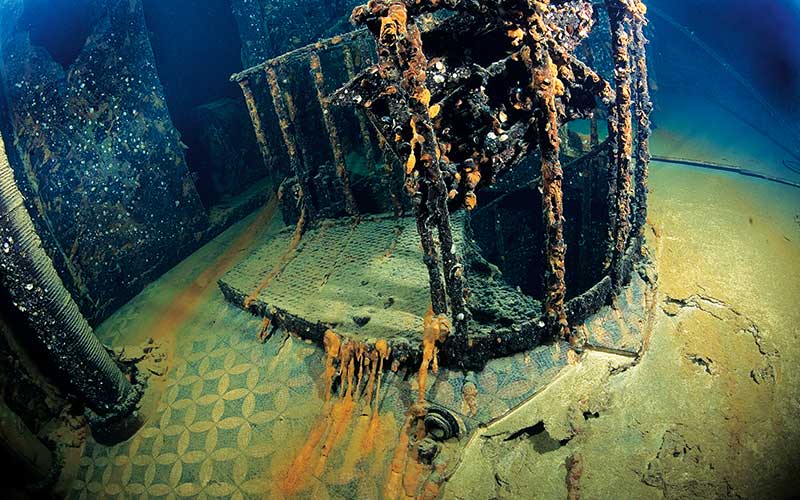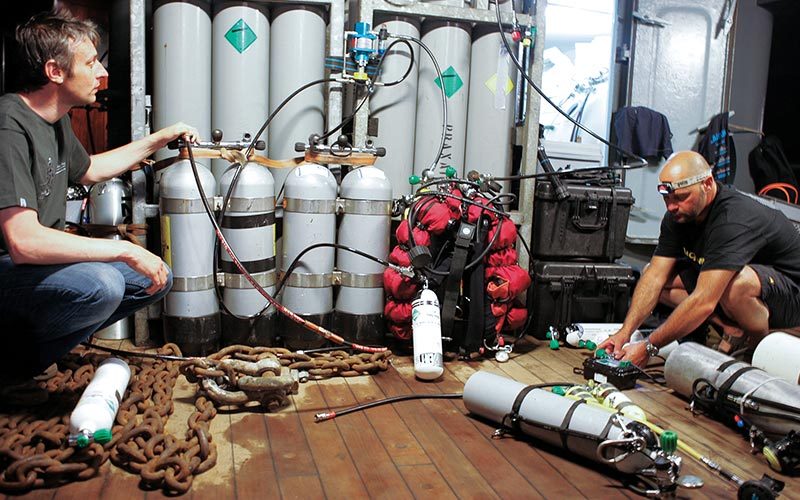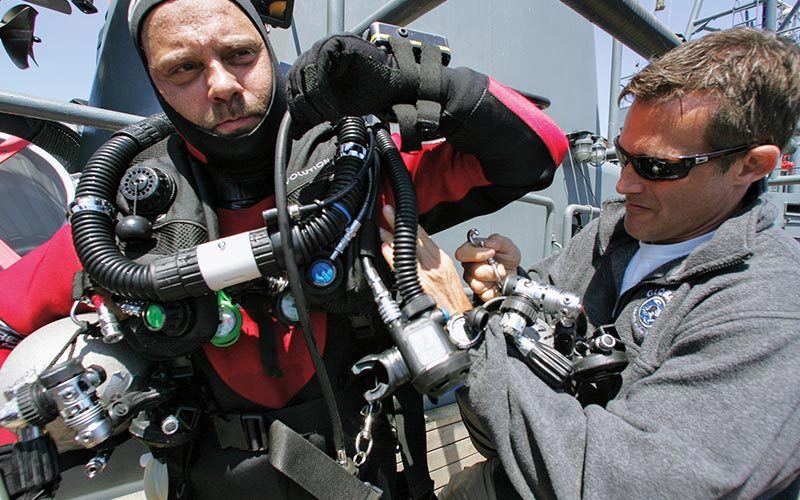Definitions of expedition diving vary by perspective. As a shipwreck explorer, my view is that expedition diving is a complex undertaking that involves a team of technical divers with tons of equipment carrying out difficult tasks based on sophisticated logistics. Most of the projects I work on require divers to go into deep water (300 feet or more) and involve in-water run times of four to eight hours. As such, the bottom divers cannot physically carry enough gas to be self-sufficient.
Although bailout or decompression gasses could be left on a line for ascending divers to use — an acceptable practice in cave diving in which there is only one way back out of the cave system — this is not a safe practice in an open-water environment. In open water, anchor or down lines can sever, divers can be separated from the team, boats can fail to start, and surface conditions can change; in any of these cases the staged gasses could become inaccessible to the divers who need them. Support divers, therefore, are a must-have component of any expedition dive plan.
Expedition dives focus on specific goals and are organized months in advance. Dives on famous deepwater shipwrecks such as the Lusitania or Britannic are prime examples of successful expedition programs. Before an expedition dive, a detailed dive plan, or standard operating procedure (SOP), is drafted. The dive plan will outline everything related to the project, from initial mobilization to postdive breakdown. All possible logistical, equipment and operational considerations must be addressed, including gas calculations, material requirements and emergency protocols, layered with proper support and backup.

An adequate SOP will clearly guide the team through expected and emergency operations, and it will account for the material requirements and physical preparation needed to get the bottom divers back to the surface regardless of the what, why, when and where. Still, no matter how well you prepare, once heads go underwater there is always inherent risk. The question is not how to eliminate risk, but rather how to identify how much risk is acceptable and where to draw the line.
Years ago, prior to my first expedition dive, I always carried all the gas I needed to make a dive, careful to leave nothing to chance. Gas waiting on the anchor line, under the boat or even on the dive boat might not be there when I needed it, so I couldn’t count on it when I planned my dive. Eventually my open-circuit trimix diving hit a wall, as I was limited by how much gas I was willing to carry and how much risk I was willing to assume.

There used to be a rumor that on really deep open-circuit dives a buddy could actually prove to be more of a liability than an asset. Back then I usually chose to dive alone — despite a deep understanding of the risks involved — because if someone did have a gas problem there simply wasn’t enough gas for two. Comfortable in my gas management, I always chose to assume that risk. Twice I’ve been jumped by out-of-air divers on Andrea Doria expeditions. The first time it happened I was blindsided and nearly drowned, having not seen it coming. In the second instance, I saw the diver coming toward me, his hand slashing across his throat. Despite my offer of a backup regulator, he bowled me over and yanked my regulator from my mouth. In both cases, dive-boat operators dropped emergency gas over the side of the boat, and the divers only suffered bruised egos and a spot on the captain’s “boat’s full” list. Both incidents occurred 20 feet beneath the boat during the decompression phase of the dive, and it seemed to me it was only a matter of time before someone had a major gas issue at depth.
That cold reality hit on a 280-foot dive after we had just located German U-boat U-215 on Georges Bank, 150 miles off Shelburne, Nova Scotia. At first, the dive was fantastic. Everything went well during the bottom phase of the dive, and I was elated — until I noticed that the other two members of my team were buddy breathing during the ascent. The tide had turned and was roaring, and it was all we could do to hold onto the ascent line. A pea-soup fog had rolled in, so the planned drift decompression had been scrapped without our knowledge. Our single support diver had experienced an issue with his (then newfangled) rebreather, so he had never splashed, and everyone topside remained unaware of the gas-management drama unfolding below.

More concerned with the fog and the possibility of losing his divers at sea, the captain didn’t think to send someone into the water to break the line free for our drift decompression or even to check on us. Splitting one cylinder of deep deco gas, the pair barely eked out a marginal profile, surfacing a little pale but no worse for the wear. When I surfaced, every gauge I had was in the red; had I been asked for gas I would have had none to give. The ripping current had forced me to work harder than I planned to, and it exacted a toll on my gas supply that took my safety margin of gas as close to the red line as I ever want to be. It was during that dive that I realized I had to change something in the way I planned and executed these types of deep dives.

My switch to closed-circuit rebreather (CCR) diving provided me a quantum leap in range but required me to totally rework my technique and philosophy of diving. Like a new open-water diver, the importance of a dive buddy returned for me, but with new significance; the bailout gas carried by a buddy is factored into my dive/emergency plan, just as my bailout is into his. We are partners now, and on deeper dives having three to four divers with communal bailout gas plans is not uncommon, although it does require a much greater obligation to stay together — a far cry from the “same dive, same ocean” mentality of days past. As a member of a CCR dive team, I have expanded my available bailout and made a commitment to accept the risk limits of my partners.
A major aspect of expedition diving is the support divers, whose single most important task is to provide gas (or a backup rebreather) to bottom divers in the case of a major unit failure. Layered support provides the ability to handle multiple situations so that no matter what issues arise, the decompression phase is as uninterrupted and stress free for the bottom divers as possible.
Besides their assigned jobs for normal or planned dives, support divers prepare for emergency scenarios such as divers adrift, gas loss, electronics failure, loop flood and even unconscious divers. Long run times can clock out a diver’s oxygen tolerance units, and central nervous system (CNS) oxygen toxicity seizures during the long decompression phase are a very real risk to expedition divers. Therefore, support divers remain in the water with the dive team during the entire shallow decompression phase, diligently monitoring them, ready to lend assistance or bring a convulsing diver to the surface. The number of support divers at the deep, intermediate and shallow levels is determined by the gas needs of the bottom divers, the environmental conditions and the size of the dive platform. It’s important to note that having more support divers in the water is not necessarily better (there’s a point at which additional divers can complicate logistics unduly).
For expedition diving, the dive marshal (DM) is the go-to person running the dive operation topside, liaising with the captain and support crew, tracking all the divers’ times and assigning tasks to support divers as required by the schedule or an emergency. In short, the DM is the final word on everything that pertains to the dive. Mirrored after military and commercial operations, the SOP and its command structure is designed to control all activity on the back deck, ensuring all aspects of the dive operations are monitored and providing clear and concise emergency protocol instructions if needed.

This article is not intended to serve as a draft of an SOP, nor could I, in this limited space, list all the nuances of a well thought-out dive plan. There are many ways to run an expedition dive, and no single SOP will work in every situation. The key is to have a written plan that covers all contingencies and to distribute and discuss the plan with the team, assigning tasks and responsibilities for both standard and emergency operations.
When I am questioned about how I execute these dives, I often half-jokingly reply: “Don’t follow me; I ain’t leading.” But the truth is that we all follow in the tracks of previous explorers who pushed the envelope, and we learn what worked while we expose, analyze and correct what didn’t. Each dive team must adapt its SOP to the unique conditions and parameters of each project. Where the footprints of previous explorers end, the next group will push further.
© Alert Diver — Q1 Winter 2015